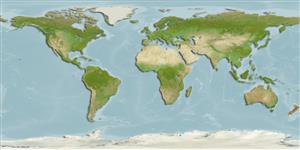>
Gobiesociformes (Clingfishes) >
Gobiesocidae (Clingfishes and singleslits) > Diplocrepinae
Etymology: Diplocrepis: Greek, diploos = twice + Greek, krepis, idos = base, foundation (Ref. 45335).
More on author: Richardson.
Environment: milieu / climate zone / depth range / distribution range
Ecologia
marinhas demersal; intervalo de profundidade 0 - 15 m (Ref. 9003). Temperate
Southwest Pacific: endemic to New Zealand.
Tamanho / Peso / Idade
Maturity: Lm ? range ? - ? cm
Max length : 12.5 cm SL macho/indeterminado; (Ref. 9003); common length : 8.5 cm SL macho/indeterminado; (Ref. 9003)
Descrição suscinta
Chaves de identificação | Morfologia | Morfometria
Espinhos dorsais (total) : 0; Raios dorsais (total) : 10 - 11; Espinhos anais: 0; Raios anais : 4 - 5. Olive pink or green to brown, red, yellow or lilac, with or without stripes, spots or bars. Breeding males with pinkish dorsal saddle. Distinguished from other clingfishes by the large, rounded head with incisorform teeth and a large, blunt posteriorly projecting spine at the lower margin of the operculum.
Common in rock pools at low tide and sub-tidally. Found clinging under rocks or boulders in more sheltered areas. Feeds on amphipods, gastropods, and fishes. Takes cover when disturbed.
Ciclo de vida ou comportamento de acasalamento
Maturities | Reprodução | Spawnings | Egg(s) | Fecundities | Larvas
Eggs are guarded by the male.
Paulin, C. and C. Roberts, 1992. The rockpool fishes of New Zealand (Te ika aaria o Aotearoa). Museum of New Zealand (Te Papa Tongarewa). 177 p. (Ref. 9003)
Status na Lista Vermelha da UICN (Ref. 130435)
Ameaça para os humanos
Harmless
Uso pelos humanos
Ferramentas
Relatórios especiais
Baixar XML
Fontes da internet
Estimates based on models
Preferred temperature (Ref.
123201): 12 - 16.5, mean 14.8 °C (based on 80 cells).
Índice de diversidade filogenética (Ref.
82804): PD
50 = 1.0000 [Uniqueness, from 0.5 = low to 2.0 = high].
Bayesian length-weight: a=0.00468 (0.00180 - 0.01218), b=3.12 (2.90 - 3.34), in cm total length, based on LWR estimates for this (Sub)family-body shape (Ref.
93245).
Nível Trófico (Ref.
69278): 3.7 ±0.63 se; based on food items.
Resiliência (Ref.
120179): médio(a), tempo mínimo de duplicação da população 1,4 - 4,4 anos (Fec = 2,500).
Fishing Vulnerability (Ref.
59153): Low vulnerability (10 of 100).
